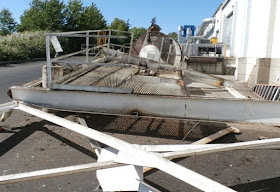Pilot seriously hurt, passenger critically injured
UPDATED 5:21 PM EDT Jun 17, 2016
CHATHAM, Mass. —A helicopter crashed Friday afternoon in Chatham and was partially submerged in the water when rescuers arrived.
The 2002 Robinson Helicopter crashed near the property of 204 Crows Pond Road. Pilot John Ryan, 48, and passenger Tyra Pacheco, 48, had to be freed by emergency personnel, police said.
Police said the helicopter had been hired to do aerial photography for a local real estate company.
Flying over the crash scene, Sky5 could see the wreckage of the small helicopter at the edge of the water.
Photos from the ground show the bent rotor blades and broken fuselage.
"It wasn't an out-of-control 360-type of crash that was happening," said witness Neil Sullivan. "Just an increase in velocity as it was going. I saw it pass the tree line and heard the thud."
"We saw it was in the water so we ran up the street and down the driveway," said Sarah Holt. "There were a couple people already on the beach."
Sullivan said he heard the passenger from the helicopter screaming in pain.
"The pilot was fantastic, keeping the passenger calm, but he was definitely expressing the pain he was in," Sullivan said.
"I could hear the girl moaning and moaning. The man wasn't too much better. He was trying to calm her down," said Eva Japowicz.
Ryan was taken to Cape Cod hospital in Hyannis with serious injuries. Pacheco was flown to Massachusetts General Hospital with critical injuries.
Ryan is from Scituate, and Pacheco is from Acushnet, police said.
Date:
17-JUN-2016
Time: 12:45 LT
Type:

Robinson R44 Raven II
Owner/operator: Ryan Rotors Inc
Registration: N141TM
C/n / msn: 1216
Fatalities: Fatalities: 0 / Occupants: 2
Other fatalities: 0
Airplane damage: Written off (damaged beyond repair)
Location: Crows Pond, North Chatham, Barnstable County, Cape Cod, MA -
 United States of America
United States of America Phase: Landing
Nature: Survey
Departure airport: Plymouth Muni (KPYM)
Destination airport: Plymouth Muni (KPYM)
Narrative:
The helicopter force landed to the west lakeshore sustaining substantial damage. The two POB were rescued and taken to hospital with serious injuries.
Sources:
http://www.tauntongazette.com/news/20160617/helicopter-crashes-in-cape-cod-pond-injuries-reported
http://www.wcvb.com/news/helicopter-crash-reported-in-crows-pond/40103556
http://www.providencejournal.com/news/20160617/helicopter-crashes-on-cape-cod-injuries-reported
http://boston.cbslocal.com/2016/06/17/helicopter-crash-chatham-cape-cod/
http://flightaware.com/resources/registration/N141TM







